Web Exclusive
Two of TU’s brightest stars: Recent alums have gone from physics undergrads to published authors
Kielan Hoch ’17 and Kelsey Glazer ’19 are pursuing new knowledge in physics and sharing it with the world.
The YSES-1 system consisting of the sun-like star (center), YSES-1b and its circumplanetary disk (right), and YSES-1c with silicate clouds in its atmosphere (left). Created by Ellis Bogat.
At a Glance
- Kielan Wilcomb Hoch and Kelsey Glazer both came to TU with backgrounds in the arts and no plans to make a career in physics.
- Hoch has earned doctorate in astrophysics and Glazer is earning a doctorate from the University of California education system (Hoch from UC-San Diego and Glazer from UC-Davis).
- Glazer has published papers on high-redshift galaxies, which are some of the first galaxies ever born in the universe. Hoch was the lead author on her most recently published paper, in a summer 2025 issue of Nature that examined the early development of two exoplanets discovered in 2020.
If you had searched for Kielan (Wilcomb) Hoch ’17 and Kelsey Glazer ’19 about 15 years ago, you would have found them about as far from studying physics as the objects they now study are from Earth.
Hoch spent 15 years as a modern dancer before enrolling at TU, and Glazer was far more focused on piano and flute, eventually playing in TU’s marching and symphonic bands. Neither enrolled as a science major but introductory physics and astronomy classes convinced Glazer and Hoch to make their academic homes in TU’s Department of Physics, Astronomy and Geosciences.
"Kielan engaged heavily in REUs, individual projects for faculty and major projects leading to publication," says Thomas Krause, associate physics professor at TU. "Knowing she could tackle a problem, more or less on her own, for which the answer was not in the back of the book was a great confidence-booster."
By the time she graduated, Hoch won two TU awards for outstanding achievement in physics, spent three summers at the Johns Hopkins Applied Physics Lab, presented on summer research projects at regional and national professional conferences and co-authored a paper in the journal Universe.
Glazer pushed through her initial concerns about a lack of aptitude in hard sciences to embark on TU research projects, a research experience for undergraduates (REU) at Texas A&M in astronomical research and instrumentation and two summer internships at the Space Telescope Science Institute (STScI).
"While Kelsey was still a junior, she called the Space Telescope Science Institute at Johns Hopkins University and got herself invited to give a lecture on our research results ... without talking to me about it!" says TU physics professor James Overduin. "People in the audience said it was better than most of the talks by visiting astronomy professors. Kelsey is someone who could very easily change the world."
Searching through the stars
Despite graduating two years apart, Glazer and Hoch ended up in the University of California system for their master’s and doctoral programs—Glazer at UC-Davis and Hoch at UC-San Diego.
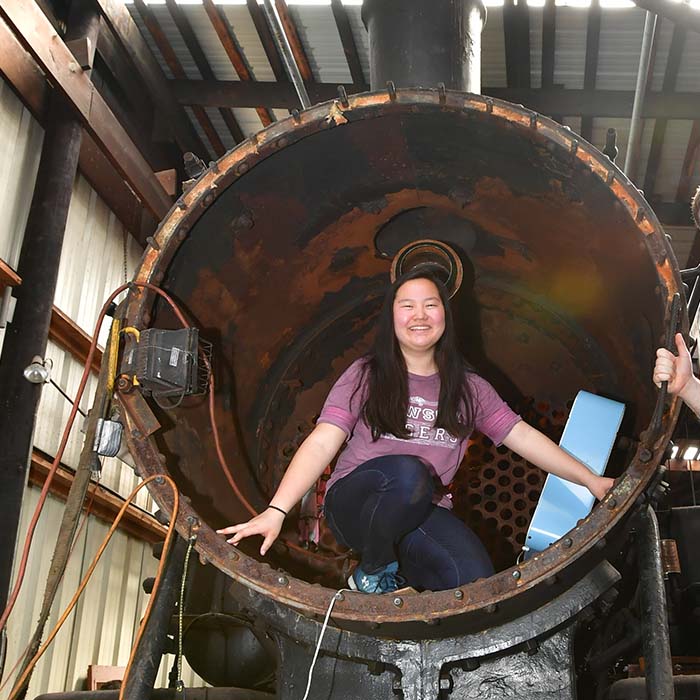
Glazer’s work focuses on high-redshift galaxies—distant galaxies that were among the first born in the universe—and the space between those galaxies, which is called the intergalactic medium (IGM). She is looking at what role the redshift galaxies may have had in affecting the ionization of hydrogen atoms in the IGM.
“In the early universe, there was a big transition where there was neutral hydrogen in the IGM that at some point was re-ionized,” she says.
“This happened in the entirety of the space between the galaxies. What I'm particularly interested in is looking at these very young, very early galaxies and seeing what their properties are, what I can learn from them and what we might be able to infer from them in terms of the role they played in re-ionizing the neutral hydrogen in the universe.”
Glazer published twice in May 2024 in the Monthly Notices of the Royal Astronomical Society. The first paper, of which she was the lead author, examined carbon II emissions in three low-mass galaxies, while the second continued her focus on re-ionization by looking at Lyman-alpha emission strength and the stellar properties of distant faint galaxies.
Her most recent paper—where she is again lead author—has been accepted and reviewed and awaits publication in Astrophysical Journal. Titled “Stacking PANCAKEZ: sPectroscopic Analysis with NirspeC stAcKs in the Epoch of reioniZation. Weak ISM Absorption and Implications for Ionizing Photon Escape at z∼7,” it makes use of James Webb Space Telescope (JWST) images of 64 galaxies to provide insights into an average high-redshift galaxy’s properties and how they may be affecting the IGM’s re-ionization.
“The JWST is bringing in wonderful data, but it’s very hard to isolate individual galaxies at such a high redshift, and it's very costly,” Glazer says. “By stacking spectra, we can look for low-ionization species absorption lines that can tell us about the hydrogen gas’s composition, temperature and density.”
Looking into the past to find the beginning
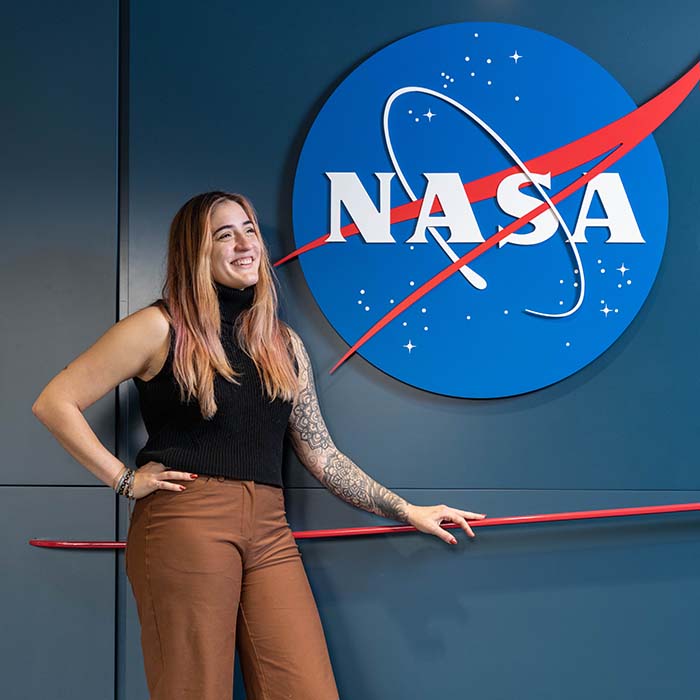
Hoch has spent the last three years at the Space Telescope Science Institute using early JWST data as a Giacconi Postdoctoral fellow—one of the most prestigious prize fellowships in astrophysics. She worked with her then-co-doctoral adviser Marshall Perrin, a tenured associate astronomer at STScI, to create a proposal for time on the inaugural cycle of the JWST to continue Hoch’s doctoral work on direct imaging spectroscopy of distant planets.
When they received approval in 2022, Hoch became one of just 8% of the principal investigators (PI) of JWST cycle one projects who were graduate students.
“The integral field spectrograph gives insight into what's going on in the atmospheres of these super-far-away objects,” Hoch says. “What we've been able to do with JWST with exoplanets has gone past anything we expected that we could get with the telescope [since it wasn’t designed for this type of use].”
Hoch’s team examined YSES-1, a star in a 16-million-year-old galaxy 307 light years away. Two still-forming gas giants (YSES-1b and YSES-1c) that are already larger than Jupiter—the biggest planet in Earth’s solar system—orbit the star. The JWST spectra revealed high-altitude clouds in YSES-1c’s atmosphere that consist of magnesium silicate dust grains and potentially iron. That means it may rain iron on that planet. Hoch told the British newspaper The Guardian these observations are the first direct detection of such clouds on a planet orbiting a sun-like star.
I'm passionate about trying to create space for diversity and bringing in people who normally wouldn't have access to exciting data or ground-breaking tools
Kielan Wilcomb Hoch
YSES-1b is encircled by a disc of tons of dust particles, which Hoch told the paper was “a puzzle for formation theories” since YSES-1c does not have a similar disc and the planets were formed in the same environment. An added mystery is why the disc still exists since astronomers theorize encircling dust should have settled after the first 5 million years.
The resulting article from these findings was published in Nature in late June, with Hoch as the lead author. She is proud that the first five authors are early-career scientists—an occurrence nearly as rare as the exoplanets they observed.
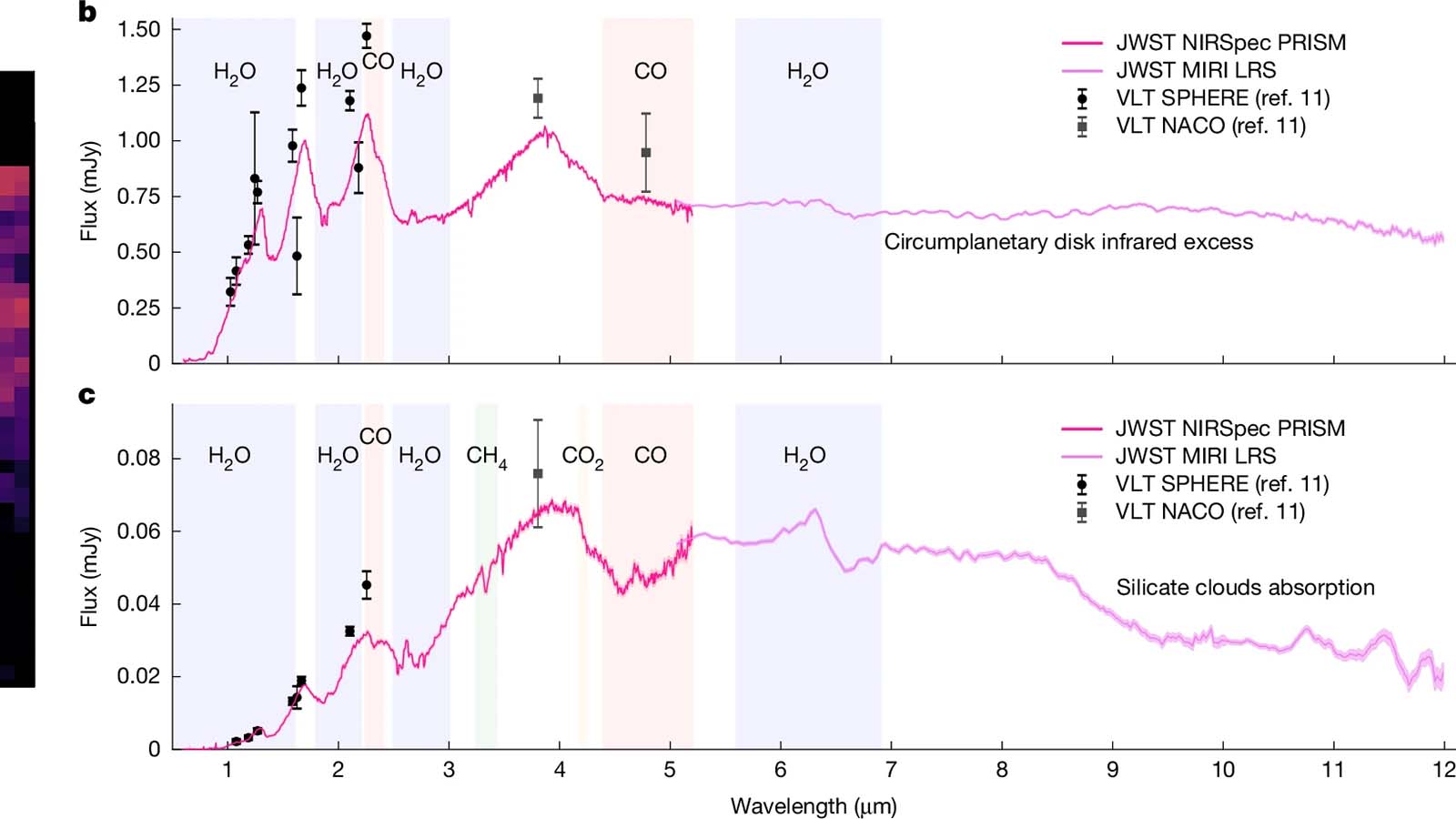
These graphs show the observed spectra of YSES-1b (top) and c as measured by the James Webb Space Telescope's Near-Infrared Spectrograph (NIRSpec PRISM) and NASA's Mid-Infrared Instrument (MIRI). The colored bars label the major molecular and continuum components.
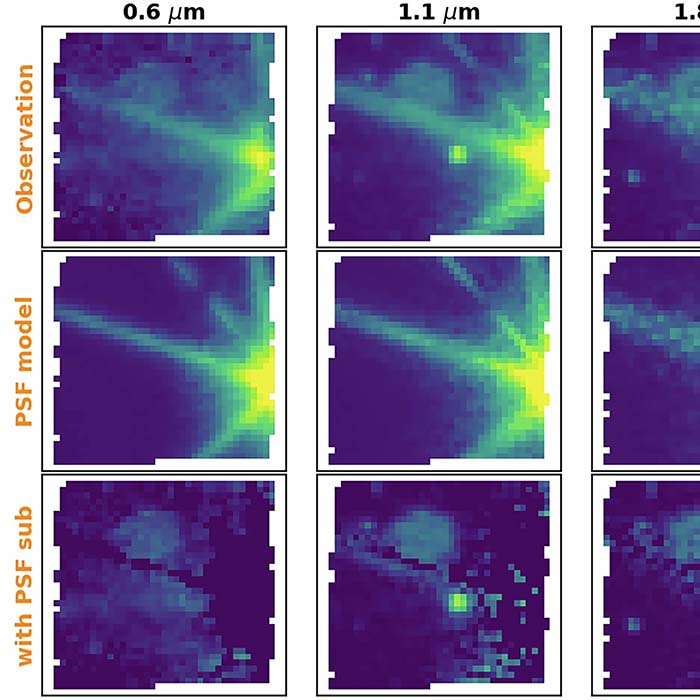
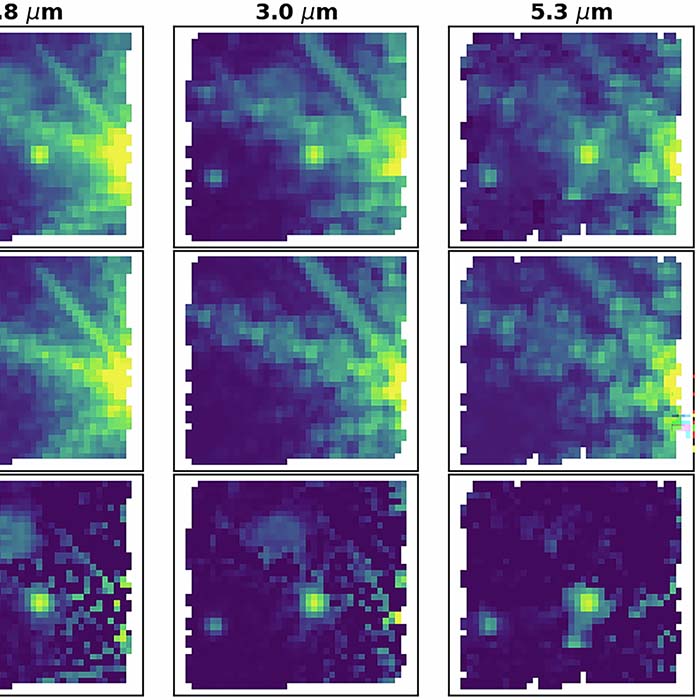
This image, from Hoch's most recent paper, shows her team's technique to filter out light from the host star to get clearer images of the two exoplanets they studied.
Hoch has given presentations about her findings at professional conferences around the world and came back to give a seminar to TU students in mid-September. Asked why she made the time, her answer is simple: the students.
Towson’s environment cultivates people who can question and analyze data and bring in that extra dimension that I think is missing.
Kielan Wilcomb Hoch
“I'm passionate about trying to create space for diversity and bringing in people who normally wouldn't have access to exciting data or ground-breaking tools,” Hoch says. “The creativity from people of diverse backgrounds is what drives innovation and a lot of these cool results—asking the weird questions and trying to figure things out in a way that's outside the box.
"I come from a place of asking, ‘What if we flipped it upside down and did it this way?’ Towson’s environment cultivates people who can question and analyze data and bring in that extra dimension that I think is missing. I’m hoping to inspire undergrad students who maybe don’t look the way you would imagine an astronomer to look to keep going.”
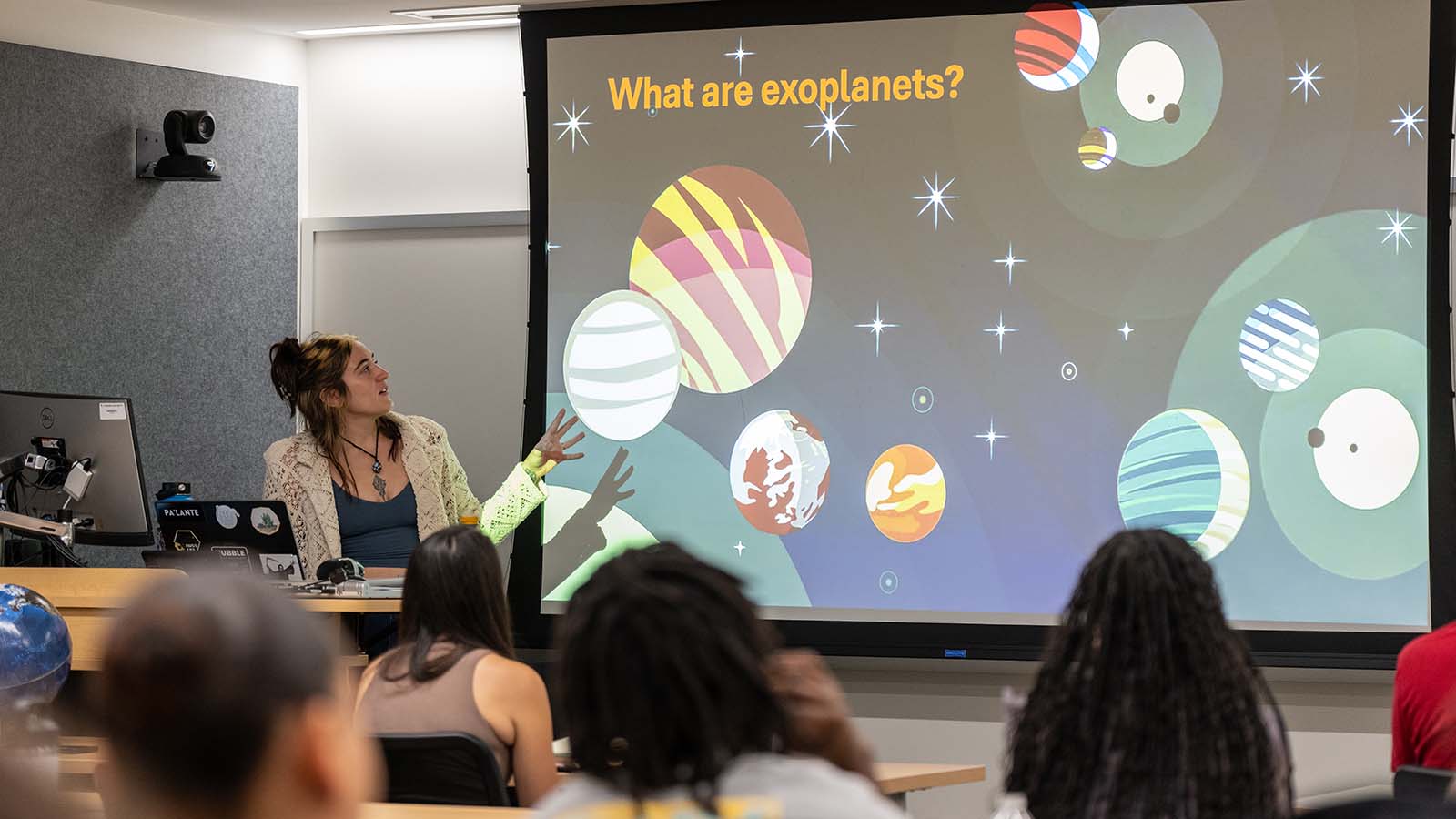
Kielan Wilcomb Hoch guest-lecturing on her findings, at the Science Complex in October 2025.
How Do We Name Exoplanets?
Exoplanet names can look long and complicated at first, especially when compared to names like Venus and Mars.
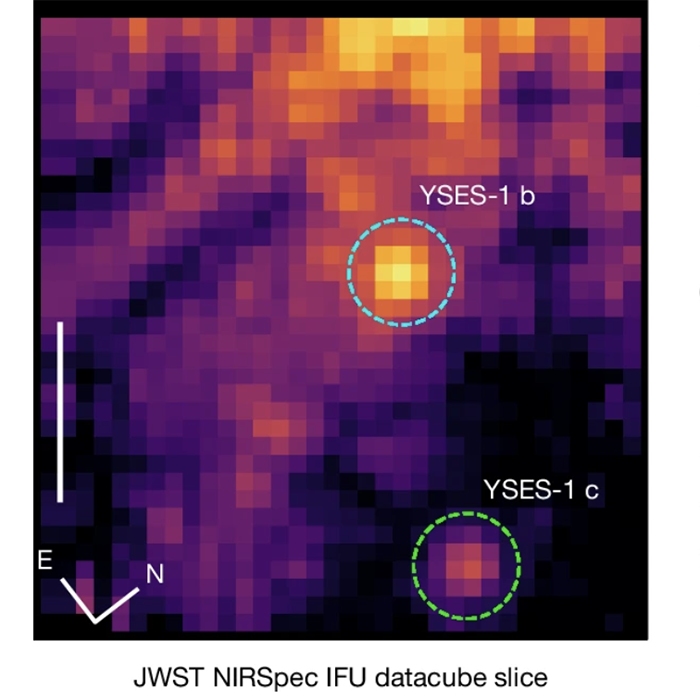
- The first part of an exoplanet name is usually the telescope or survey that discovered it.
- The number is the order in which the star was cataloged by position.
- The lowercase letter stands for the planet, in the order in which the planet was found.
- The first planet found is always named b, with ensuing planets named c, d, e, f and so on.
- The star that the exoplanet orbits is usually the undeclared "A" of the system, which can be useful if the system contains many stars, which themselves may be designated B or C. (Stars get capital letters; planets receive lowercase designations.)
- If a bunch of exoplanets around the same star are found at once, the planet closest to its star is named b with more distant planets named c, d, e and so on.
That’s how the exoplanets YSES-1b and YSES-1c discovered by Kielan Hoch’s team acquired their unusual names: YSES-1 (after the star they orbit) and b and c as lowercase designations according to their distances from that star.